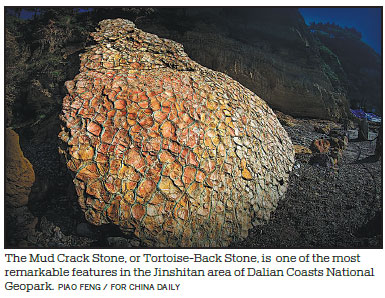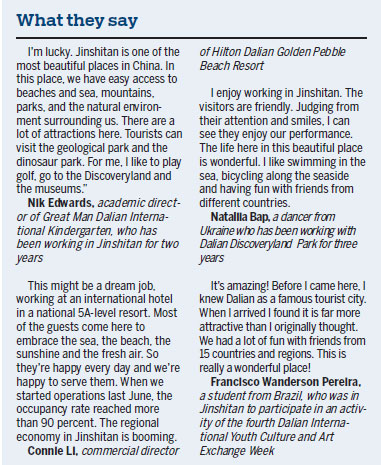Landscape helps national geopark draw visitors
The Jinshitan area of Dalian Coasts National Geopark is now becoming a major tourist attraction in Dalian with its picturesque landscape and value for science education.
Local statistics show the Jinshitan section of the geopark, which is also a part of the Jinshitan National Tourism Resort in Dalian's Jinpu New Area, has attracted about 400,000 visits annually in recent years.
Scientists believe the landform of the eastern coast of Jinshitan, which features strange rocks and steep cliffs, was formed between 300 million and 900 million years ago.
According to Shan Xuedong, vice-director of the Liaoning Provincial Institute of Geological Exploration, the area's landscape was formed as part of the long-term erosion of seawater.
Shan also noted the area has various stratums formed at the junction of the Sinian and Cambrian period, due to the deposit of silts.
"Such a landform is rarely seen in the rest of the country and it offers valuable evidence for the study of ancient geology and environment," Shan said.
According to Bi Yunfeng, general manager of Jinshitan Tourism Group, the area's value in tourism lies in the strange rocks that resemble shapes of animals and even human beings, like monkeys, dinosaurs, huge birds, crabs and even the head of Beethoven.
"A casual snapshot here can make for a great photograph," Bi said, adding the clear seawater and white-sand beaches in Jinshitan can also offer a perfect tour for leisure-seeking travelers.
The most remarkable feature in Jinshitan is the Mud Crack Stone, which is also known as Tortoise-Back Stone among Chinese tourists.
The huge stone is a rare sedimentary rock displaying a wonderful mud-crack structure.
There are two views about the origin of this site among scientists.
Some believe the mud crack occurred when calcic silts were deposited and then exposed aerially in the dry and hot weather about 540 million years ago. Another opinion is that the site was formed when an earthquake caused cracks perpendicular to the rock bedding.
According to Bi, Jinshitan became a tourist destination in the 1980s. Tourism development has been made based on the protection of the unique landscape of the geopark.
A tour of the geopark takes two to three hours, for tourists ranging from sightseers and geological enthusiasts to researchers.


(China Daily 08/27/2019 page12)














